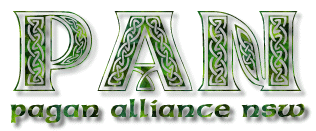|
Lughnasadh 1998 Newsletter About Lughnasadh |

|
Lughnasadh is generally celebrated between the 31st January and the 2nd February, depending on the tradition. Lughnasadh is pronounced Loo-nus-uh and takes its name from the Irish God Lugh. The Interpretato Romania (a Roman text about the Celts) likens Lugh to their God Mercury.
Lughnasadh is a harvest festival, where in days of old people would gather together, play games, race horses and feast in celebration of the harvest. In medieval times, Lughnasadh came to be called Lammas (by the Christian folk), which means 'loaf mass'. This refers to the custom of offering bread and cakes, made from the grains of the harvest, to their God. Some traditions include a further two harvests in the season of Autumn, that of fruit and meat one month apart.
In days of old, the King was the symbol of the fertile nation. If the King was strong so was the land. The King represents the God on earth and would be ritually killed to ensure the lands survival. This act of ritual killing is known as the act of the Dying and Rising God. The King will die, so that the land may be born anew.
Lughnasadh is when we start to notice the days getting shorter. We have begun to witness the descent of the sun into the underworld where it will wait until the Winter Solstice, where it will be reborn, to bring new life to the frozen landscape.
Traditional activities at this time of the year include placing a selection of your harvest on your altar, or in your outdoor sacred space, as an offering of thanks for the harvest in your lives. One way to share the bounty of the harvest in this modern world (where it is not easy to see the time elapse between the harvests due to 24 hour shopping and modern convenience foods), may be to organise a feast to share your food with friends. Alternatively you might like to donate some food to charity so that others may share in the Earth's abundance.
Other activities include making corn dollies from wheat. If you are unable to gather your own wheat, or corn stalks, you can purchase these from most craft stores or florists. You may like to weave corn dollies in your sacred space, or get the kids involved out in the back yard. It is also a traditional time to engage in other craft activities.
![]()